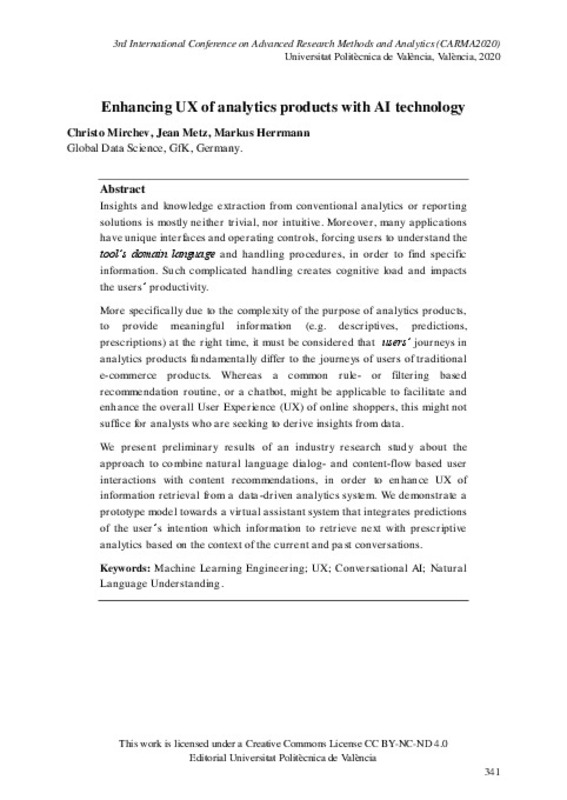JavaScript is disabled for your browser. Some features of this site may not work without it.
Buscar en RiuNet
Listar
Mi cuenta
Estadísticas
Ayuda RiuNet
Admin. UPV
Enhancing UX of analytics products with AI technology
Mostrar el registro sencillo del ítem
Ficheros en el ítem
| dc.contributor.author | Mirchev, Christo
|
es_ES |
| dc.contributor.author | Metz, Jean
|
es_ES |
| dc.contributor.author | Herrmann, Markus
|
es_ES |
| dc.date.accessioned | 2020-07-28T11:12:18Z | |
| dc.date.available | 2020-07-28T11:12:18Z | |
| dc.date.issued | 2020-07-10 | |
| dc.identifier.isbn | 9788490488324 | |
| dc.identifier.uri | http://hdl.handle.net/10251/148778 | |
| dc.description.abstract | [EN] Insights and knowledge extraction from conventional analytics or reporting solutions is mostly neither trivial, nor intuitive. Moreover, many applications have unique interfaces and operating controls, forcing users to understand the tool’s domain language and handling procedures, in order to find specific information. Such complicated handling creates cognitive load and impacts the users’ productivity. More specifically due to the complexity of the purpose of analytics products, to provide meaningful information (e.g. descriptives, predictions, prescriptions) at the right time, it must be considered that users’ journeys in analytics products fundamentally differ to the journeys of users of traditional e-commerce products. Whereas a common rule- or filtering based recommendation routine, or a chatbot, might be applicable to facilitate and enhance the overall User Experience (UX) of online shoppers, this might not suffice for analysts who are seeking to derive insights from data. We present preliminary results of an industry research study about the approach to combine natural language dialog- and content-flow based user interactions with content recommendations, in order to enhance UX of information retrieval from a data-driven analytics system. We demonstrate a prototype model towards a virtual assistant system that integrates predictions of the user’s intention which information to retrieve next with prescriptive analytics based on the context of the current and past conversations. | es_ES |
| dc.language | Inglés | es_ES |
| dc.publisher | Editorial Universitat Politècnica de València | es_ES |
| dc.rights | Reconocimiento - No comercial - Sin obra derivada (by-nc-nd) | es_ES |
| dc.subject | Web data | es_ES |
| dc.subject | Internet data | es_ES |
| dc.subject | Big data | es_ES |
| dc.subject | Qca | es_ES |
| dc.subject | Pls | es_ES |
| dc.subject | Sem | es_ES |
| dc.subject | Conference | es_ES |
| dc.subject | Machine Learning Engineering | es_ES |
| dc.subject | UX | es_ES |
| dc.subject | Conversational AI | es_ES |
| dc.subject | Natural Language Understanding | es_ES |
| dc.title | Enhancing UX of analytics products with AI technology | es_ES |
| dc.type | Capítulo de libro | es_ES |
| dc.type | Comunicación en congreso | es_ES |
| dc.rights.accessRights | Abierto | es_ES |
| dc.description.bibliographicCitation | Mirchev, C.; Metz, J.; Herrmann, M. (2020). Enhancing UX of analytics products with AI technology. Editorial Universitat Politècnica de València. 341-341. http://hdl.handle.net/10251/148778 | es_ES |
| dc.description.accrualMethod | OCS | es_ES |
| dc.relation.conferencename | CARMA 2020 - 3rd International Conference on Advanced Research Methods and Analytics | es_ES |
| dc.relation.conferencedate | Julio 08-09,2020 | es_ES |
| dc.relation.conferenceplace | Valencia, Spain | es_ES |
| dc.relation.publisherversion | http://ocs.editorial.upv.es/index.php/CARMA/CARMA2020/paper/view/11615 | es_ES |
| dc.description.upvformatpinicio | 341 | es_ES |
| dc.description.upvformatpfin | 341 | es_ES |
| dc.type.version | info:eu-repo/semantics/publishedVersion | es_ES |
| dc.relation.pasarela | OCS\11615 | es_ES |






